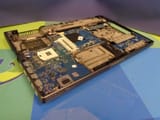Search Results
7/22/2025, 6:23:12 PM
>>1534335
>How do I solve this problem without soldering in a more powerful CPU? (impossible)
It should be socketed, in which case you could upgrade it, but you're already near the top of what's compatible.
>the 2.00 GHz CPU can be somehow boosted to 2.9 GHz
Turbo boost. Should be enabled already.
Install `i7z` and run it to monitor the frequencies.
Run a single core stress test (e.g. with `stress -c 1`).
You should see one core boosting to 2.9 GHz.
>thread count doubled somehow
Hyperthreading. Should also be enabled already.
Run `lscpu`, and you should see `Thread(s) per core: 2`.
>It says CPU is running at 99% meaning the CPU must be the bottleneck of this build.
Not necessarily.
As >>1534438 said, you need to install old legacy drivers to get a Fermi GPU working.
As it is, you're either not using the Nvidia GPU at all (IGP instead), or you are, but with the crappy Nouveau drivers.
Considering you need Optimus to switch to the Nvidia GPU, it's probably the former.
Now, with 390.xx, you don't get official support for Optimus with PRIME.
As such, you'd have to use some hackish solution like Bumblebee.
https://wiki.archlinux.org/title/NVIDIA_Optimus
Honestly, you'd have a much easier time getting everything working right with Windows 10.
Although it's going out of support, there's IoT Enterprise LTSC 2021 that's supported until 2032.
For download and activation: https://massgrave.dev/
Optimus, Boost, and Hyperthreading should all be working without a hitch.
If you insist on using Linux, there's CachyOS, which recently dethroned Linux Mint on DistroWatch.
It's Arch-based, so although much of the info in the Arch wiki can transfer to Mint, it'd apply nearly 100% to CachyOS.
>How do I solve this problem without soldering in a more powerful CPU? (impossible)
It should be socketed, in which case you could upgrade it, but you're already near the top of what's compatible.
>the 2.00 GHz CPU can be somehow boosted to 2.9 GHz
Turbo boost. Should be enabled already.
Install `i7z` and run it to monitor the frequencies.
Run a single core stress test (e.g. with `stress -c 1`).
You should see one core boosting to 2.9 GHz.
>thread count doubled somehow
Hyperthreading. Should also be enabled already.
Run `lscpu`, and you should see `Thread(s) per core: 2`.
>It says CPU is running at 99% meaning the CPU must be the bottleneck of this build.
Not necessarily.
As >>1534438 said, you need to install old legacy drivers to get a Fermi GPU working.
As it is, you're either not using the Nvidia GPU at all (IGP instead), or you are, but with the crappy Nouveau drivers.
Considering you need Optimus to switch to the Nvidia GPU, it's probably the former.
Now, with 390.xx, you don't get official support for Optimus with PRIME.
As such, you'd have to use some hackish solution like Bumblebee.
https://wiki.archlinux.org/title/NVIDIA_Optimus
Honestly, you'd have a much easier time getting everything working right with Windows 10.
Although it's going out of support, there's IoT Enterprise LTSC 2021 that's supported until 2032.
For download and activation: https://massgrave.dev/
Optimus, Boost, and Hyperthreading should all be working without a hitch.
If you insist on using Linux, there's CachyOS, which recently dethroned Linux Mint on DistroWatch.
It's Arch-based, so although much of the info in the Arch wiki can transfer to Mint, it'd apply nearly 100% to CachyOS.
Page 1
